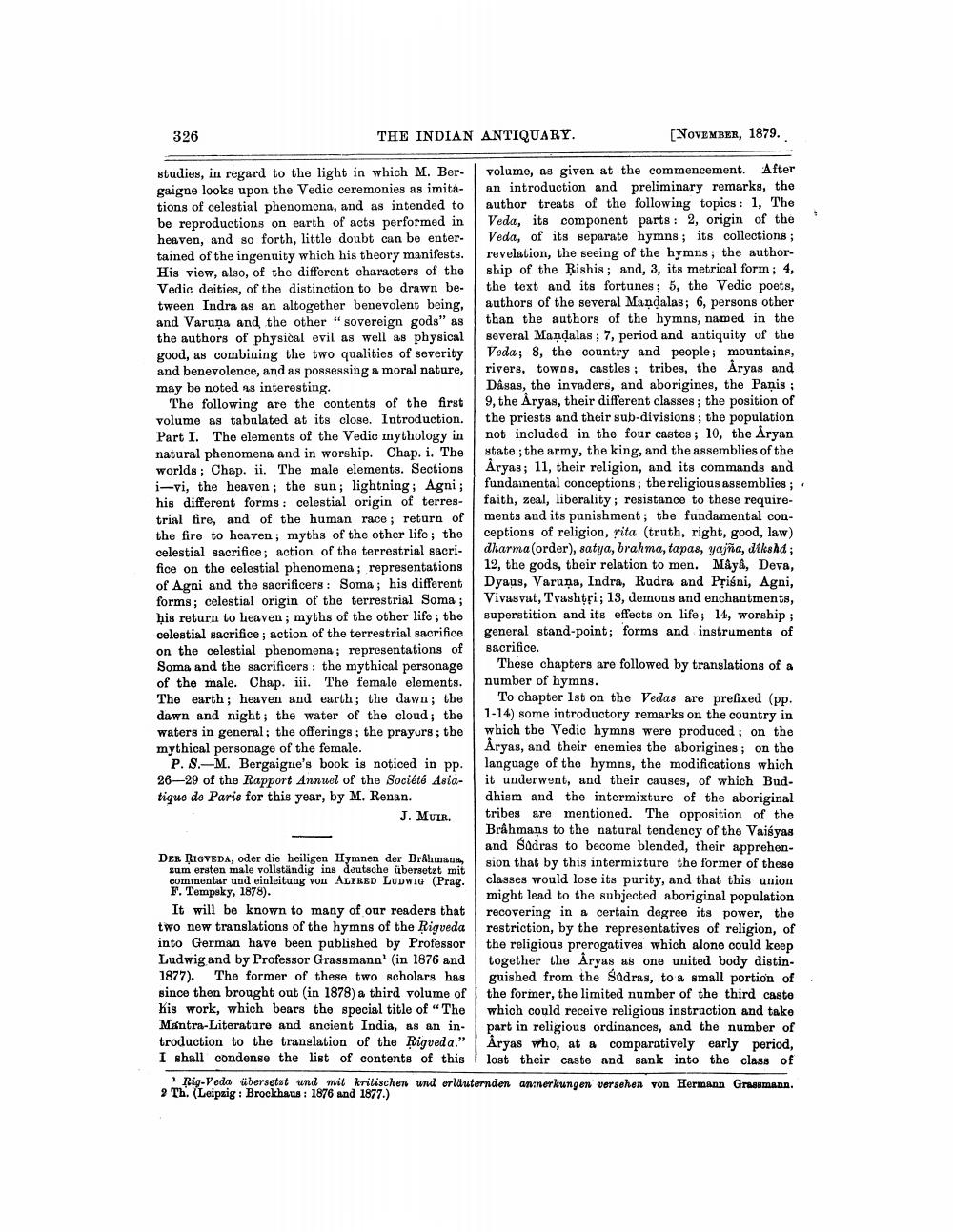________________
326
THE INDIAN ANTIQUARY.
[NOVEMBER, 1879.
studies, in regard to the light in which M. Ber- volume, as given at the commencement. After gaigne looks upon the Vedic ceremonies as imita- an introduction and preliminary remarks, the tions of celestial phenomena, and as intended to author treats of the following topics : 1, The be reproductions on earth of acts performed in Veda, its component parts: 2, origin of the heaven, and so forth, little doubt can be enter- Veda, of its separate hymns; its collections ; tained of the ingenuity which his theory manifests. revelation, the seeing of the hymns; the authorHis view, also, of the different characters of the ship of the Rishis; and, 3, its metrical form; 4, Vedic deities, of the distinction to be drawn be- the text and its fortunes; 5, the Vedic poets, tween Indra as an altogether benevolent being, authors of the several Mandalas; 6, persons other and Varuna and the other "sovereign gods" as than the authors of the hymns, named in the the authors of physical evil as well as physical Beveral Mandalas ; 7, period and antiquity of the good, as combining the two qualities of severity Veda; 8, the country and people; mountains, and benevolence, and as possessing a moral nature, | rivers, towns, castles ; tribes, the Aryas and may be noted as interesting.
Dåsas, the invaders, and aborigines, the Paņis: The following are the contents of the first 9, the Aryas, their different classes; the position of volume as tabulated at its close. Introduction, the priests and their sub-divisions; the population Part I. The elements of the Vedic mythology in not included in the four castes ; 10, the Aryan natural phenomena and in worship. Chap. i. The state ; the army, the king, and the assemblies of the worlds ; Chap. ii. The male elements. Sections Aryas; 11, their religion, and its commands and
-yi. the heaven: the sun: lightning: Agni ; fundamental conceptions; the religious assemblies; his different forms: celestial origin of terres- faith, zoal, liberality; resistance to these requiretrial fire, and of the human race; return of ments and its punishment; the fundamental conthe fire to heaven; myths of the other life; the ceptions of religion, rita (truth, right, good, law) celestial sacrifice; action of the terrestrial sacri- dharma(order), satya, brahma, tapas, yajña, dikshd; fice on the celestial phenomena; representations 12, the gods, their relation to men. M&ya, Deva, of Agni and the sacrificers: Soma; his different Dyaus, Varuna, Indra, Rudra and Prisni, Agni, forms; celestial origin of the terrestrial Soma; Vivasvat, Trashtri; 13, demons and enchantments, his return to heaven; myths of the other life; the superstition and its effects on life; 14, worship; celestial sacrifice; action of the terrestrial sacrifice general stand-point; forms and instruments of on the celestial phenomena; representations of sacrifice. Soms and the sacrificers: the mythical personage These chapters are followed by translations of a of the male. Chap. iii. The femalo elements. number of hymns. The earth; heaven and earth; the dawn; the To chapter ist on the Vedas are prefixed (pp. dawn and night; the water of the cloud; the 1-14) some introductory remarks on the country in waters in general; the offerings; the prayurs; the which the Vedio hymns were produced ; on the mythical personage of the female.
Åryas, and their enemies the aborigines; on the P. S.-M. Bergaigne's book is noticed in pp. language of the hymns, the modifications which 26-29 of the Rapport Annuel of the Société Asia- it underwent, and their causes, of which Budtique de Paris for this year, by M. Renan.
dhism and the intermixture of the aboriginal J. MUIR.
tribes are mentioned. The opposition of the Brahmans to the natural tendency of the Vaisyas
and Sadras to become blended, their apprehenDER RIGVEDA, oder die heiligen Hymnen der Brahmana, zum ersten male vollständig ins deutsche übersetat mit
sion that by this intermixture the former of these commentar und einleitung von ALFRED LUDWIG (Prag. classes would lose its purity, and that this union F. Tempeky, 1878).
might lead to the subjected aboriginal population It will be known to many of our readers that recovering in a certain degree its power, the two new translations of the hymns of the Rigveda restriction, by the representatives of religion, of into German have been published by Professor the religious prerogatives which alono could keep Ludwig and by Professor Grassmann (in 1876 and together the Åryas as one united body distin1877). The former of these two scholars has guished from the Sadras, to a small portion of since then brought out (in 1878) a third volume of the former, the limited number of the third caste his work, which bears the special title of "The which could receive religious instruction and take Mantra-Literature and ancient India, as an in- part in religious ordinances, and the number of troduction to the translation of the Rigveda." Aryas who, at a comparatively early period, I shall condense the list of contents of this lost their caste and sank into the class of
Rig Veda übersetst und mit kritischen und erläuternden aminerkungen versehen von Hermann Grasmann. 9 Th. (Leipzig : Brockhaus: 1876 and 1877.)




